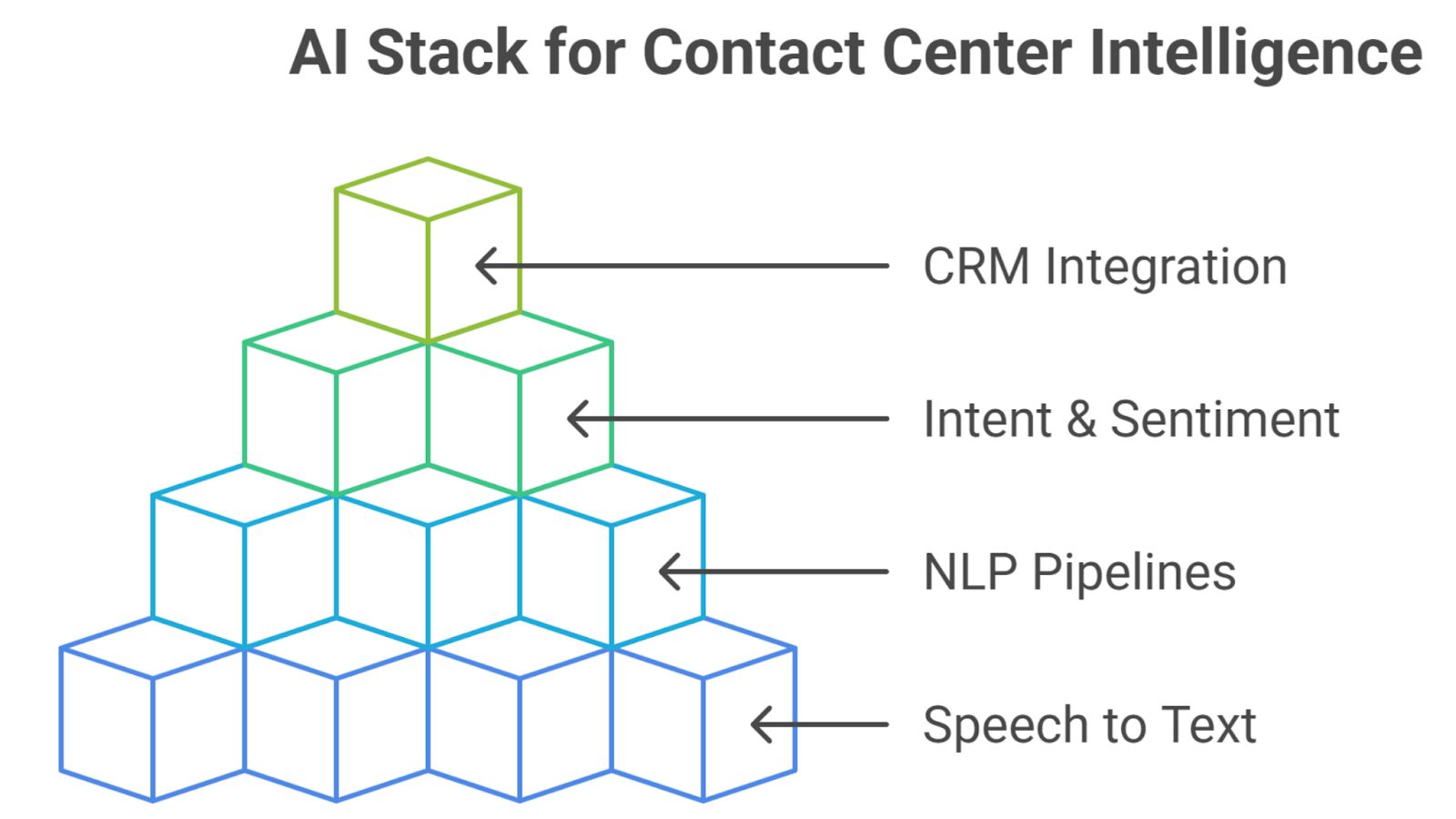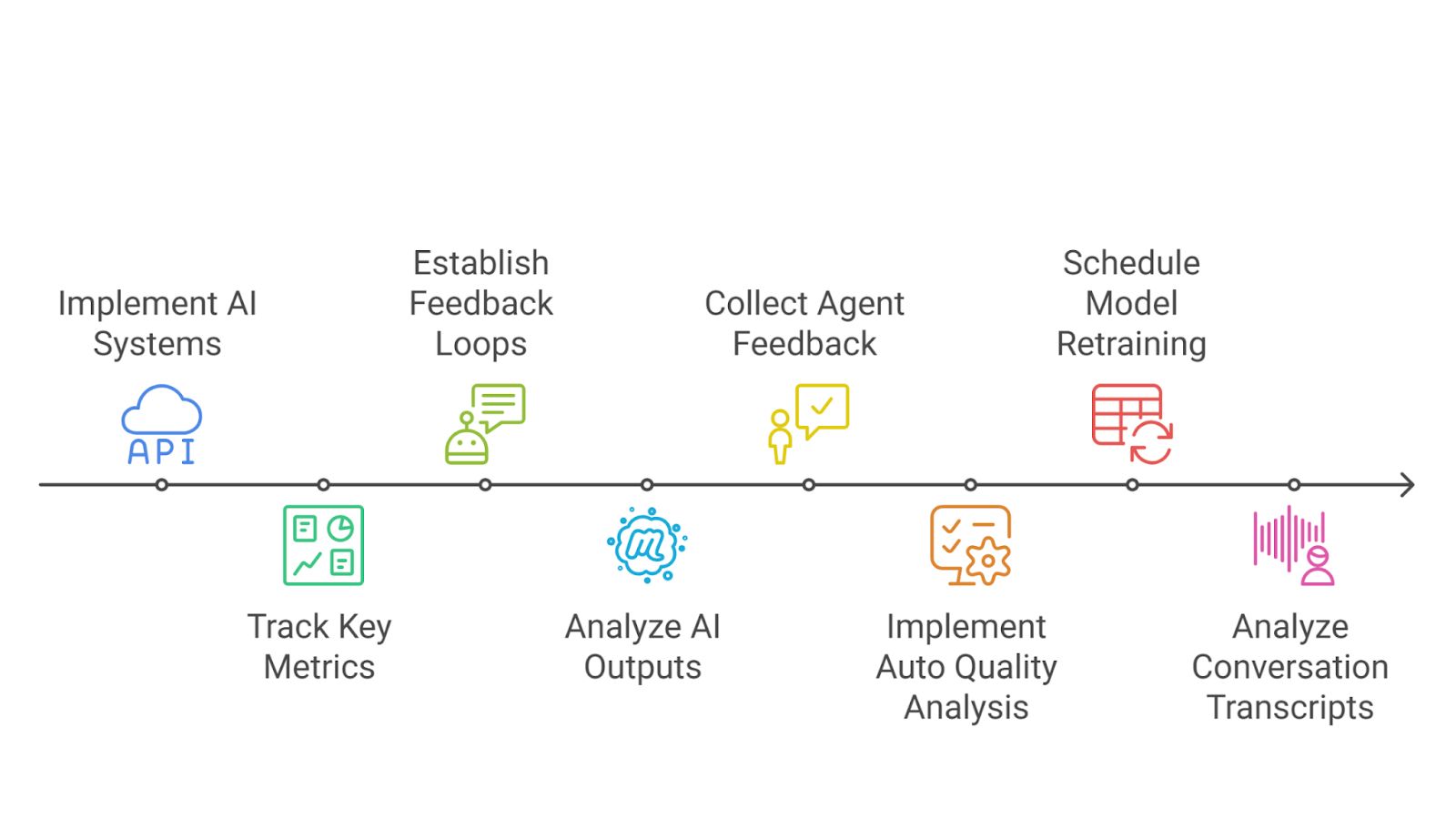Artificial intelligence call center technology is growing at an unprecedented rate of 21.3% annually. We're witnessing a fundamental shift in how customer service operates, with 75% of CX leaders believing support team skillsets will look drastically different within three years as agents evolve into AI managers. This transformation isn't surprising considering that 82% of customers now expect immediate problem resolution from service agents.
So this guide provides the technical framework you need to start.
Core Use Cases of AI in Call Centers
Implementing AI for call centers delivers measurable performance improvements across multiple operational areas. Let's examine the four foundational use cases that form the backbone of modern contact center intelligence.
AI Agents for Complex Query Resolution
AI agents have evolved beyond basic chatbots to handle sophisticated customer interactions autonomously. These advanced systems can resolve complex issues without human intervention, processing queries across multiple channels including WhatsApp, Facebook, and RCS. In practical implementations, AI agents have demonstrated the ability to regardless of complexity. For instance, when Camping World deployed an IBM Watson AI powered virtual assistant named Arvee, agent efficiency increased by 33% and customer engagement improved by 40%.automate up to 80% of customer interactions
Conversational IVR for Natural Language Routing
Traditional menu driven IVR systems are being replaced by conversational interfaces that understand natural language. According to research, 82% of consumers express dissatisfaction with traditional IVR systems, yet companies using conversational IVR score . These systems leverage Natural Language Processing (NLP) to comprehend caller intent, enabling customers to express needs in their own words rather than navigating complex menus. Consequently, calls are routed more accurately, reducing unnecessary transfers and improving first call resolution rates.33.9% higher in customer satisfaction
Real Time Agent Assist with Knowledge Suggestions
Real time agent assist tools provide immediate guidance to human agents during live customer interactions. This technology has demonstrated a 23% reduction in Average Handle Time (AHT) and 10% uplift in conversions across 350+ enterprises. The system works by analyzing conversations in real time through speech analytics or NLP, then surfacing relevant knowledge articles, compliance reminders, and suggested responses. Additionally, Level AI customer ezCater reported a 13% drop in average handle time and a 23% decrease in call hold times during peak support hours.
Predictive Analytics for Call Volume Forecasting
AI powered forecasting uses historical data and external factors to predict future call volumes with greater accuracy than traditional methods. Through machine learning algorithms, these systems analyze patterns from call logs, seasonal trends, and even social media sentiment to optimize staffing levels. Notably, T Mobile implemented an AI forecasting system that reduced forecast error by 30% and saved millions in operational costs. This approach ensures adequate coverage during peak periods without overstaffing during quieter times.
Building the AI Stack for Contact Center Intelligence
Constructing a robust technical foundation is essential for any successful artificial intelligence call center implementation. The AI stack consists of specialized components that work together to process, analyze, and act on customer interactions.

Speech to Text Engines and NLP Pipelines
First, high quality speech recognition sits at the foundation of contact center AI. Modern speech to text engines achieve impressive accuracy through advanced neural networks and billions of text sentences. These systems support over 125 languages and variants, enabling global deployment. The processing pipeline typically involves:trained on millions of hours of audio data
- Data acquisition from call recordings or live audio streams
- Preprocessing to clean audio and remove noise
- Feature extraction to identify linguistic patterns
- Transcription with automatic punctuation and speaker diarization
Natural language processing (NLP) pipelines subsequently transform raw transcripts into structured data. This process includes tokenization, lemmatization, and removal of stop words to prepare text for analysis. The accuracy of these systems varies by provider, with Google Cloud Speech to Text, Amazon Transcribe, and Microsoft Azure all offering competitive solutions with different .pricing models ranging from $0.02 to $1.00 per audio hour
Intent Detection and Sentiment Scoring Models
Intent detection models classify customer statements into actionable categories. These classification systems identify what customers want to accomplish, with top solutions achieving F1 scores above 70%. Advanced models leverage machine learning to improve over time through continuous training with real conversation data.
Simultaneously, sentiment analysis models evaluate customer emotions during interactions. These systems analyze both linguistic content and acoustic features like pitch, tone, and speaking rate. Modern sentiment analysis goes beyond simple positive/negative classification to detect specific emotions such as anger, disappointment, gratitude, and happiness.
Integration with CRM and Ticketing Systems
Moreover, the AI stack must connect with existing business systems. Integration with CRM platforms enables AI to access customer history and preferences, providing context for interactions. Similarly, AI ticketing systems automatically categorize, prioritize, and route customer issues to appropriate departments. This integration creates a seamless flow of information between automated and human touchpoints, ensuring consistent customer experiences regardless of channel.
In essence, a well designed AI stack transforms raw customer interactions into structured, actionable insights while maintaining the conversational nature that customers expect.
Operationalizing AI: From Pilot to Production
Moving from concept to reality with an AI call center requires a methodical approach. Initially, you'll need to establish a clear implementation strategy that aligns with your organization's goals and customer expectations.
Running A/B Tests for AI vs Human Performance
Successful AI implementation begins with limited pilots and controlled testing. Start with a focused use case, such as improving first call resolution (FCR) or shortening agent ramp time. Run comparison tests between AI assisted and traditional approaches to measure performance differences. These tests should track key performance indicators including:
- Average handling time (AHT)
- Customer satisfaction scores (CSAT)
- Quality assurance metrics
- First call resolution rates
In practice, organizations implementing AI have seen significant improvements, with executives reporting that . Indeed, properly conducted A/B tests reveal where AI excels and where human agents still provide superior value.AI has boosted productivity in 54% of workplaces
Scaling AI Workflows Across Channels
Once pilot tests prove successful, expand AI capabilities methodically across additional channels and use cases. Notably, AI call center systems can handle thousands of simultaneous interactions, making them ideal for managing volume spikes without proportionally increasing staff. This scalability is particularly valuable during seasonal surges or product launches.
Why make a big bet on an AI call center when you can start with your AI voice agent and scale as you grow? This approach allows you to fine tune your implementation before full deployment.
AI powered contact centers utilize predictive analytics to forecast support volume and optimize agent allocation, hence . By analyzing historical data patterns, these systems help prepare for scaling operations during peak periods reducing operational costs while maintaining service quality
Fallback Mechanisms for AI Escalation
Yet, even the most sophisticated AI requires robust fallback procedures. Design clear escalation paths that allow customers to reach human agents when AI cannot resolve their issues. Specifically, implement systems that recognize when to transfer interactions, ensuring all context from the AI conversation is passed to the human agent.
The most effective implementations recognize that AI should complement rather than replace human agents. Therefore, transparency about when customers are interacting with AI and reassurance that human help remains available helps build trust in your AI call center.
Measuring Success and Continuous Optimization
Effective measurement forms the cornerstone of any successful AI call center implementation. Once your AI systems are operational, tracking performance and continuous refinement become essential to maximize return on investment.

Key Metrics: AHT, CSAT, FCR, and AI Accuracy
Tracking specific metrics provides visibility into your AI call center's performance.
Average Handle Time (AHT) measures how long agents spend handling customer calls, including talk time, hold time, and post call work. This metric helps identify efficiency opportunities, though speed must balance with quality service.
Customer Satisfaction (CSAT) directly measures how satisfied customers are with their experience through post interaction surveys.
First Call Resolution (FCR) tracks the percentage of issues resolved during the initial contact without requiring follow ups a metric where top performers like Amazon achieve over 90% through excellent agent training. For AI specifically, Error Rate quantifies system accuracy by measuring the percentage of interactions resulting in misunderstandings. Call centers using AI can analyze 100% of interactions rather than sampling, removing human bias from quality assessments.
Feedback Loops from QA and Agent Reviews
Establishing structured feedback channels enables continuous improvement. Quality assurance teams should systematically evaluate AI generated outputs to ensure they accurately reflect conversations and adhere to compliance standards.
These reviews help identify where AI models need refinement. Agent feedback is equally valuable continuous input from frontline staff regarding AI performance helps align systems with best practices.
By implementing auto quality analysis, organizations can evaluate every interaction rather than sampling, highlighting both strengths and improvement areas. These systems can detect patterns that might be missed through manual monitoring, fundamentally transforming how call centers measure performance.
Model Retraining Schedules and Data Refresh Cycles
AI models require regular updates to maintain accuracy. When agents reroute incorrectly predicted interactions, this feedback should be automatically collected for future retraining. Above all, establish clear retraining configurations with filtering criteria for problematic predictions. Many organizations implement monthly retraining schedules, allowing AI to "relearn" from recent interactions. This approach creates a virtuous cycle where the system continuously improves by incorporating new data patterns. By tracking metrics like deflection rate, resolution time, and CSAT, then analyzing conversation transcripts to update training data and intents, you optimize your AI systems for best results.
Conclusion
AI powered call centers represent the future of customer service technology, as we've explored throughout this comprehensive guide. The 21.3% annual growth rate confirms what forward thinking organizations already know AI has become essential rather than optional for competitive contact center operations.
FAQs
Q1. How can I implement AI in my call center?
To implement AI in your call center, start by assessing your current operations and choosing the right AI technology based on your needs.
Q2. What are the typical costs associated with an AI powered call center?
The costs of an AI call center vary widely depending on factors such as the type of AI solution, integration complexity, and call volume. Basic AI tools can start around $15,000, while advanced AI software may range from $200,000 to $700,000.
Q3. Will AI completely replace human agents in call centers?
While AI can handle routine tasks and improve efficiency, it's unlikely to completely replace human agents. AI excels at automating simple inquiries and providing quick responses, but human agents are still essential for complex problem solving, emotional intelligence, and building customer rapport.
Q4. What are the key metrics for measuring the success of an AI powered call center?
Important metrics for evaluating AI call center performance include Average Handle Time (AHT), Customer Satisfaction (CSAT), First Call Resolution (FCR), and AI Accuracy
Q5. How often should AI models be retrained in a call center environment?
AI models in call centers should be retrained regularly to maintain accuracy and adapt to changing customer needs. Many organizations implement monthly retraining schedules, allowing the AI to learn from recent interactions.
See a working AI call center now: book a SuperU voice agent demo.


